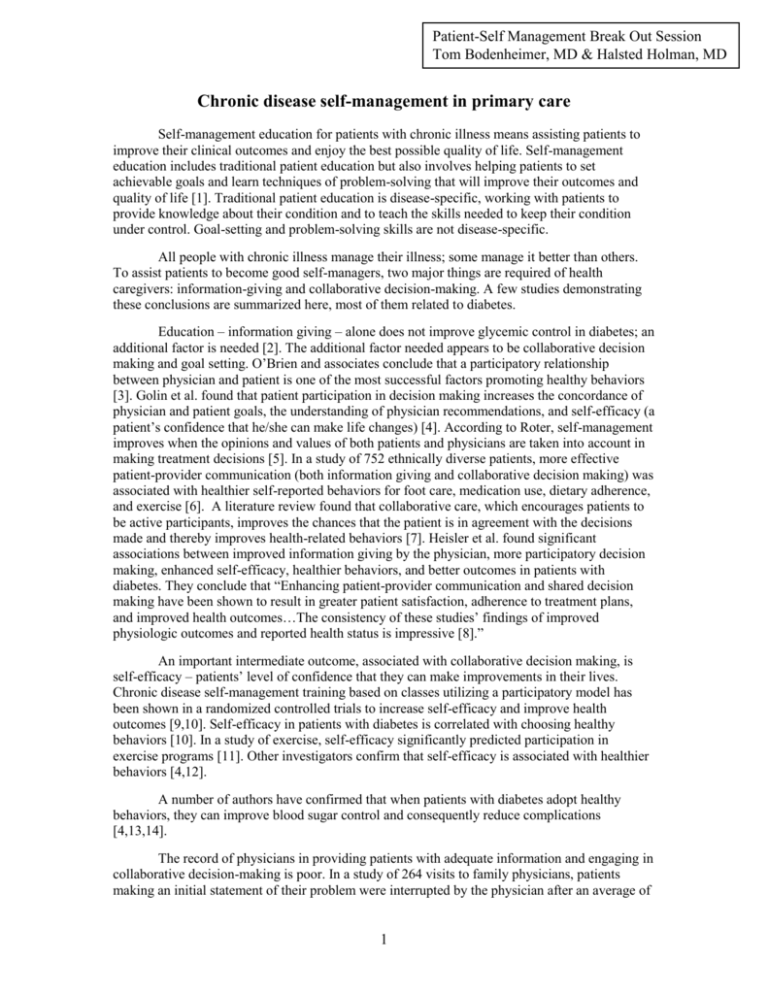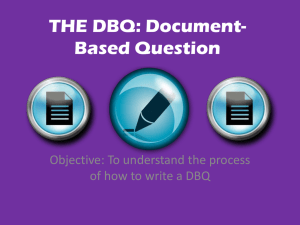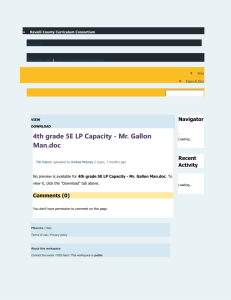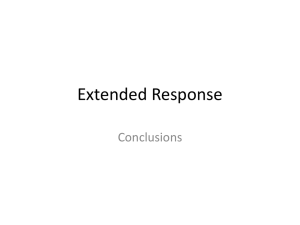Self-management - Improving Chronic Illness Care
advertisement

Patient-Self Management Break Out Session Tom Bodenheimer, MD & Halsted Holman, MD Chronic disease self-management in primary care Self-management education for patients with chronic illness means assisting patients to improve their clinical outcomes and enjoy the best possible quality of life. Self-management education includes traditional patient education but also involves helping patients to set achievable goals and learn techniques of problem-solving that will improve their outcomes and quality of life [1]. Traditional patient education is disease-specific, working with patients to provide knowledge about their condition and to teach the skills needed to keep their condition under control. Goal-setting and problem-solving skills are not disease-specific. All people with chronic illness manage their illness; some manage it better than others. To assist patients to become good self-managers, two major things are required of health caregivers: information-giving and collaborative decision-making. A few studies demonstrating these conclusions are summarized here, most of them related to diabetes. Education – information giving – alone does not improve glycemic control in diabetes; an additional factor is needed [2]. The additional factor needed appears to be collaborative decision making and goal setting. O’Brien and associates conclude that a participatory relationship between physician and patient is one of the most successful factors promoting healthy behaviors [3]. Golin et al. found that patient participation in decision making increases the concordance of physician and patient goals, the understanding of physician recommendations, and self-efficacy (a patient’s confidence that he/she can make life changes) [4]. According to Roter, self-management improves when the opinions and values of both patients and physicians are taken into account in making treatment decisions [5]. In a study of 752 ethnically diverse patients, more effective patient-provider communication (both information giving and collaborative decision making) was associated with healthier self-reported behaviors for foot care, medication use, dietary adherence, and exercise [6]. A literature review found that collaborative care, which encourages patients to be active participants, improves the chances that the patient is in agreement with the decisions made and thereby improves health-related behaviors [7]. Heisler et al. found significant associations between improved information giving by the physician, more participatory decision making, enhanced self-efficacy, healthier behaviors, and better outcomes in patients with diabetes. They conclude that “Enhancing patient-provider communication and shared decision making have been shown to result in greater patient satisfaction, adherence to treatment plans, and improved health outcomes…The consistency of these studies’ findings of improved physiologic outcomes and reported health status is impressive [8].” An important intermediate outcome, associated with collaborative decision making, is self-efficacy – patients’ level of confidence that they can make improvements in their lives. Chronic disease self-management training based on classes utilizing a participatory model has been shown in a randomized controlled trials to increase self-efficacy and improve health outcomes [9,10]. Self-efficacy in patients with diabetes is correlated with choosing healthy behaviors [10]. In a study of exercise, self-efficacy significantly predicted participation in exercise programs [11]. Other investigators confirm that self-efficacy is associated with healthier behaviors [4,12]. A number of authors have confirmed that when patients with diabetes adopt healthy behaviors, they can improve blood sugar control and consequently reduce complications [4,13,14]. The record of physicians in providing patients with adequate information and engaging in collaborative decision-making is poor. In a study of 264 visits to family physicians, patients making an initial statement of their problem were interrupted by the physician after an average of 1 23 seconds [15]. In a 1994 study, 76% of patients with non-insulin dependent type 2 diabetes received limited or no diabetes education [16]. Numerous studies show that as many as 50% of patients leave an office visit not understanding what they were told by the physician [17]. According to Schillinger et al., when physicians asked patients with diabetes to restate the physician’s instructions – indicating that they understood what the physician said – the patients’ HbA1c levels were lower than patients who were not given the opportunity to restate what they were told. This technique of assessing a patient’s understanding is called “closing the loop.” In this study, physicians closed the loop during only 12% of discussions of new information (a new lifestyle change recommendation or new medication). When asked to restate new information, patients responded incorrectly 47% of the time. Thus closing the loop, a simple technique of assessing patients’ understanding, has the potential to improve patient comprehension and diabetes outcomes [18]. Braddock et al. studied over 1000 audiotaped visits with 124 physicians in community practice. In 91% of decisions made in those visits, the patient was not truly informed of the options and consequences related to the decision; i.e. the patient was not engaged in collaborative decision-making [19]. Given the inadequacy of physician communication and patient comprehension, it is not surprising that approximately 50% of patients do not follow physician instructions in caring for their chronic illness [20]. The ideal chronic disease self-management program must concern itself with 1) improved disease-specific information giving and 2) collaborative decision-making and goal-setting such that patients embrace the behavior changes needed to improve outcomes and will gain the confidence (self-efficacy) to make the most of life regardless of their chronic condition. The Ideal Self-Management Program Information giving This is disease-specific Make list (e.g. from ADA for diabetic patients) of all the information/skills patients need to be good self-managers – measuring sugars, diets, exercise, checking feet, understanding importance of A1c, BP, LDL, knowing about complications, etc. Arrange that patients receive all this information and skills, using a motivational interviewing technique and “closing the loop.” Motivational interviewing technique: ask-tell-ask Ask patients: what do you know about your diabetes? What would you like to know? Then tell them what they would like to know, rather than throwing 50 facts at them all at once. After giving the information the patient is interested in, ask if the patient has more questions/wants more information. Patients are far more likely to retain the information if it is information they want to know [21]. Closing the loop After giving information, ask “Please let me know how you understood what I said about..” Closing the loop is associated with improved glycemic control in diabetic patients [18]. 2 Creating a team Physicians do not have time to do adequate information-giving in the 15 minute acute visit. Teams must be created in primary care with one or more team members responsible for information-giving. Most information-giving will be done by health educators, diabetes nurse specialists, pharmacists, promotoras – this depends on what is available in the primary care practice and its surrounding institution. All team members should be trained in ask-tell-ask and closing the loop. Collaborative decision-making Negotiate agenda for each visit. If patients have something on their mind that isn’t dealt with, they probably won’t hear what the clinician wants them to hear Rather than telling patients what to do to manage their chronic condition, elicit suggestions from them or make suggestions to them – create a partnership. For example, “I think it is important for you to take Metformin. This is why and these are the side effects. What do you think?” Regarding health-related behavior change, physicians should encourage patients, but do not have time to get involved in the lengthy process of agreeing on goals and doing follow-up. A primary care team is needed to engage in goal-setting, involving such caregivers as health educators, nurses, pharmacists, medical assistants, or promotoras, who would engage in the collaborative process of assessing readiness (importance and confidence), discussing action plans, and conducting follow-up. The team needs to be trained in collaborative goal-setting. Tools for encouraging healthy behavior change (action plans) Allow patient to pick domain of behavior change Use “bubble chart” or action plan form (examples at end of this handout). See if patient is interested in doing any health behavior improvement If not, clinician should provide some information about risks caused by unhealthy behaviors. More lengthy motivational interviewing intervention will be needed that is probably not possible in primary care [21]. If patient picks a domain, assess readiness to make a change Readiness = importance and confidence If patient doesn’t think it’s important, he/she won’t make a change. Give information If patient thinks change is important, but has no confidence that he/she can change, assess and try to increase confidence Increasing confidence: On 0-10 scale, how confident are you that you can ____ (exercise more, eat better diet, take your medications, stop smoking) If patient says 4 out of 10, ask why not a 1. That encourages patient to say why they are somewhat confident Then ask, What would it take to increase confidence from 4 to 8. That might suggest an action plan Goal-setting (action plan): Let’s say the patient says, My confidence to exercise would increase to an 8 if my brother would exercise with me 3 That leads to a possible action plan: Tomorrow I will call my brother and ask if he would exercise with me three times a week Action plan should be specific, with a definite time when it will be done. It should have high probability of success in order to increase self-efficacy If the brother agrees, then next action plan can be made, for example, my brother and I will walk for 30 minutes on Monday, Wednesday and Friday every week Regular follow-up is crucial for goal-setting, and for problem-solving if there is difficulty achieving the action plan Who does the goal-setting and the follow-up is a key question for a primary care practice to figure out. Physicians do not have time. Assessing readiness (importance and confidence) and engaging in goal-setting can be done in part by computer (touch screen in office, PDA, or web). Follow-up can be done by automated phone systems, e-mail or interactive web programs. There needs to be a person backing up any computer system because the person-toperson interaction/trust is an important feature of successful self-management education. References 1. Bodenheimer T, Lorig K, Holman H, Grumbach K. Patient self-management of chronic disease in primary care. JAMA 2002;288:2469-2475. 2. Norris SL, Engelgau MM, Narayan KMV. Effectiveness of self-management training in type 2 diabetes. Diabetes Care 2001;24:561-587. 3. O’Brien MK, Petrie K, Raeburn J. Adherence to medication regimens: updating a complex medical issue. Medical Care Review 1992;49:435-454. 4. Golin CE, DiMatteo MR, Gelberg L. The role of patient participation in the doctor visit. Diabetes Care 1996;19:1153-1164. 5. Roter DL. Patient participation in the patient-provider interaction. Health Education Monographs 1997;5:281-315. 6. Piette JD, Schillinger D, Potter MB, Heisler M. Dimensions of patient-provider communication and diabetes self-care in an ethnically diverse population. J Gen Intern Med 2003;18:624-633. 7. Mead N, Bower P. Patient-centred consultations and outcomes in primary care: a review of the literature. Patient Educ Counsel 2002;48:51-61. 8. Heisler M, Bouknight RR, Hayward RA, et al. The relative importance of physician communication, participatory decision making, and patient understanding in diabetes selfmanagement. J Gen Intern Med 2002;17:243-252. 9. Lorig KR, Ritter P, Stewart AL, et al. Chronic disease self-management program: 2-year health status and health care utilization outcomes. Medical Care 2001;39:1217-1223. 10. Anderson RM, Funnell MM, Butler PM, et al. Patient empowerment. Results of a randomized controlled trial. Diabetes Care 1995;18:943-949. 4 11. McAuley E. Self-efficacy and the maintenance of exercise participation in older adults. J Behav Med 1993;16:103-113. 12. Sherbourne CD, Hays RD, Ordway L, et al. Antecedents of adherence to medical recommendations. J Behav Med 1992;15:447-468. 13. Lang F. The evolving roles of patient and physician. Arch Fam Med 2000;9:65-66. 14. Kravitz RL, Hays RD, Sherbourne CD, et al. Recall of recommendations and adherence to advice among patients with chronic medical conditions. Arch Intern Med 1993;153:1869-1878. 15. Marvel MK, Epstein RM, Flowers K, Beckman HB. Soliciting the patient’s agenda. JAMA 1999;281:283-287. 16. Clement S. Diabetes self-management education. Diabetes Care 1995;18:1204-1214. 17. Roter DL, Hall JA. Studies of doctor-patient interaction. Annual Rev Public Health 1989;10:163-180. 18. Schillinger D, Piette J, Grumbach K et al. Closing the loop. Physician communication with diabetic patients who have low health literacy. Arch Intern Med 2003;163:83-90. 19. Braddock CH, Edwards KA, Hasenberg NM, Laidley TL, Levinson W. Informed decision making in outpatient practice. JAMA 1999;282:2313-2320. 20. Lutfey KE, Wishner WJ. Beyond compliance is adherence. Diabetes Care 1999;22:635-639. 21. Rollnick S, Mason P, Butler C. Health Behavior Change. A Guide for Practitioners. Edinburgh: Churchill Livingstone, 2003. Collaborative Goal-Setting Dialogues Scenario 1: patient is ready to change Doc: I think we've talked before about things you could do to improve your cholesterol [use diabetes, or blood pressure, heart problems -- whatever the patient's problems are). We've talked about eating better, doing more exercise, stopping your cigarettes, taking your pills more regularly, and reducing the stress in your life. Is there anything you would like to do that would help to improve your cholesterol? Patient: I think I need to lose weight. Doc, when I come in here next month I'll be down 20 pounds. I promise you. Doc: Would you mind if we do a reality check? How sure are you that you can really lose 20 pounds in one month. That's not easy to do. Let's use a 0 to 10 scale: 0 means you aren't sure you can succeed and 10 means you are very sure you can succeed [have a prop available to show patient]. How sure are you that you can succeed? Patient: well, doc, maybe it’s a 3 out of 10. 5 Doc: let's think of an action plan that has a greater chance of success. Are there ways you might change your diet or increase your exercise so that you can lose some weight? Patient: I love cheese. I'll stop eating any cheese. Then I'll lose weight. Doc: on the same 0 to 10 scale, how sure are you that you can stop eating any cheese. Patient: maybe it's 5 out of 10. Doc: I really want you to succeed. Let's try an action plan that you feel sure you can do. Any ideas? Patient: if I eat one slice of cheese twice a week, I think I can do it. 8 out of 10. Doc: Great. That will be your action plan. When do you want to start? Patient: I'm starting right now. Doc: OK. Why don't we sign this agreement that you will only eat one slice of cheese twice a week, starting now. I'll sign here, and you can sign over here. Patient: signs. Doc: someone will be calling you in about a week to see how you are doing with your action plan. Take this copy home and put it on your refrigerator to remind you. Also, we'll discuss it when you come back in a month. Scenario 2: patient is ambivalent about changing Doc: It looks as if your cholesterol level has gone up a bit in the lab test we just did. Is there anything you would like to do that would help to improve your cholesterol? Patient: no, I think I'm doing fine. I'm taking my pills and they seem to be working OK. Then I don't have to worry about eating my pork rinds, because the pills protect me. Doc: what do you like about eating pork rinds and other foods with a lot of fat? Patient: it really tastes good. And it reduces my stress. When I feel stress, I eat and I feel relaxed. Doc: that makes sense. Is there anything you don't like about eating pork rinds? [Motivational interviewing technique: ask what people like and don’t like about an unhealthy behavior. Nonjudgmental and encourages patients to talk themselves into change] Patient: well, I know they make me fat. Sometimes I wish I weren't so overweight. But I'd rather be overweight than feel that stress. Doc: is there anything you could think of that might help reduce your stress that wouldn't make you more overweight? Patient: maybe I could walk around the block a couple of times to get the stress out of my body. 6 Doc: do you want to give that a try? Patient: sure, but I'm not promising to give up my pork rinds. Doc: I understand. Let's do a reality check? How sure are you that you can walk around the block a couple of times when you feel stress? Let's use a 0 to 10 scale: 0 means you aren't sure you can succeed and 10 means you are very sure you can succeed . How sure are you that you can succeed? Patient: Oh, doc, I can do that. It's a ten slam dunk. Doc: great. Why don't we call it your action plan -- that you will walk around the block two times every time you feel that stress coming on. When do you want to start? Patient: We’ll see. [Some resistance] Doc: do you want to start this week? Patient: that might be nice [Doc unable to get firm commitment from patient] Doc: OK. Why don't we sign this agreement that you will walk around the block two times every time you feel stress. I'll sign here, and you can sign over here. [Doc “rolls with the resistance, doesn’t push patient to do something patient doesn’t want] Patient: signs. Doc: someone will be calling you in about a week to see how you are doing with your action plan. Take this copy home to remind you. Also, we'll discuss it when you come back in a month. Scenario 3: patient needs to deal with social problem before being able to think about other health issues Doc: Now that we've discussed your blood pressure pills, I'd like to ask you a question: are there any problems you are having in your life that are really bothering you? Patient: it's my daughter. She's 37 and she still lives at home and she's an alcoholic and she brings people into the house and they get violent. It scares me. Doc: no wonder your blood pressure is so high. That's a tough problem. Have you thought about what you might want to do about it? Patient: I've got to get her out of the house. If she weren't there, things would be so much better. I know that wouldn't help her but it sure would help me. But I don't know how to do it? Doc: do you have any ideas how you might do it? Patient: I need to get the courage to tell her that she's got to move out. I've never even told her. Doc: maybe the first step is to sit down with her and tell her. That could be your action plan to start working on this problem. 7 Patient: OK. I'm going to sit her down. Doc: Would you mind if we do a reality check? How sure are you that you can get up the courage to tell her that you want her to leave? That's not easy to do. Let's use a 0 to 10 scale: 0 means you aren't sure you can succeed and 10 means you are very sure you can succeed. How sure are you that you can succeed? Patient: well, doc, maybe it’s a 3 out of 10. Doc: let's think of an action plan that has a greater chance of success. Do you have any ideas? Patient: maybe if she comes in here and I talk to her with you being here to help me. Doc: I'd be happy to help. What do think are the chances that she would come to the visit? Patient: I think it's 8 out of 10. If I tell her that you wanted her to come to talk about my health she'd come. Doc: When do you want to talk to her about coming to an appointment with me? Patient: this week, before Saturday. Doc: Great. That will be your action plan. Why don't we sign this agreement that before Saturday you will ask your daughter to come to an appointment with me. We'll make the appointment now, for next week. I'll sign here, and you can sign over here. Patient: signs. Doc: I'll see you next week. If for some reason something comes up, someone will call you to see how you are doing with your action plan. 8









